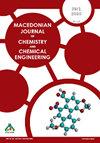Novel tyrosinase-based bisphenol-A biosensor for the determination of bisphenol-A in bracket adhesive in orthodontics
IF 1.1
4区 化学
Q3 CHEMISTRY, MULTIDISCIPLINARY
Macedonian Journal of Chemistry and Chemical Engineering
Pub Date : 2022-12-31
DOI:10.20450/mjcce.2022.2585
引用次数: 0
Abstract
A novel biosensor for the determination of Bisphenol-A has been developed in this study. For this purpose, a carbon paste electrode modified with poly(amidoamine)-salicylidenimine platinum(II) (PAMAM-Sal-Pt(II)) and the tyrosinase enzyme was prepared. BPA determination was based on the electrochemical reduction of an enzymatically produced quinone compound at –0.15 V. Optimum working conditions for the prepared biosensor were investigated. The linear working range and detection limit were found to be 0.01–1.0 μM and 1 nM, respectively. The optimum pH value and working temperature were defined as 7.0 and 40 ℃, respectively. The reproducibility of the biosensor is very good. It was found that phenol, nitrophenol, urea, potassium nitrate, hexane, acetonitrile, and ethyl acetate do not interfere with the BPA determination. The prepared biosensor was used for the first time in dentistry for the determination of BPA in a resin-based composite material used as a bracket adhesive in orthodontics.基于酪氨酸酶的新型双酚a生物传感器用于正畸支架粘接剂中双酚a的测定
本研究开发了一种新型的双酚A生物传感器。为此,制备了以聚(氨基胺)-水杨柳二胺铂(II) (PAMAM-Sal-Pt(II))和酪氨酸酶修饰的碳糊电极。双酚a的测定是基于在-0.15 V的电化学还原酶产生的醌化合物。对制备的生物传感器的最佳工作条件进行了研究。线性工作范围为0.01 ~ 1.0 μM,检出限为1 nM。确定最佳pH值为7.0℃,最佳工作温度为40℃。该生物传感器的重现性很好。发现苯酚、硝基酚、尿素、硝酸钾、己烷、乙腈和乙酸乙酯对BPA的测定没有干扰。制备的生物传感器首次用于口腔正畸支架粘接剂树脂基复合材料中BPA的测定。
本文章由计算机程序翻译,如有差异,请以英文原文为准。
求助全文
约1分钟内获得全文
求助全文
来源期刊
CiteScore
1.60
自引率
20.00%
发文量
14
审稿时长
>12 weeks
期刊介绍:
Macedonian Journal of Chemistry and Chemical Engineering (Maced. J. Chem. Chem. Eng.) is an official publication of the Society of Chemists and Technologists of Macedonia. It is a not-for-profit open acess journal published twice a year. The journal publishes original scientific papers, short communications, reviews and educational papers from all fields of chemistry, chemical engineering, food technology, biotechnology and material sciences, metallurgy and related fields. The papers published in the Journal are summarized in Chemical Abstracts.

 求助内容:
求助内容: 应助结果提醒方式:
应助结果提醒方式:


